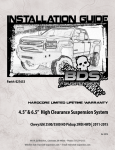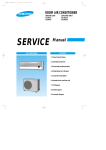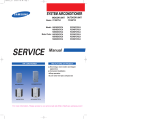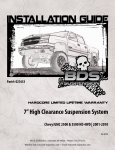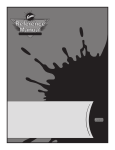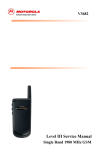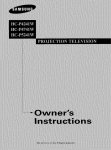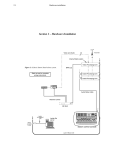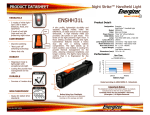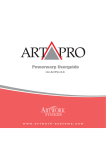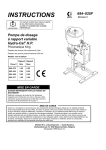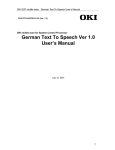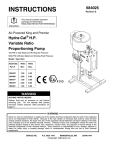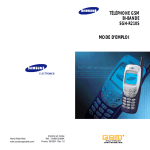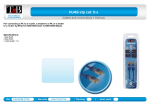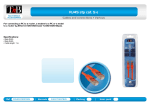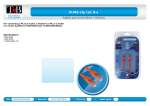Download Graco 309024C User's Manual
Transcript
Instructions Parts HYDRA-CATR VARIABLE RATIO Proportioning Pumps 309024C *Includes Automatic Pressure Relief Valves, Check Valves, Pressure Gauges and Regulators Basic Operation for Use with Configured Models Important Safety Instructions Read all warnings and instructions in this manual. Save these instructions. WARNING Plural Component Materials Hazard Graco Inc. does not manufacture or supply any of the reactive chemical materials that may be used in this equipment and is not responsible for their effects. Because of the vast number of chemicals that could be used and their varying chemical reaction, before using this equipment the buyer and the user should determine all facts relating to the materials used, including any of the potential hazards involved. Particular inquiry and investigation should be made into the potential dangers relating to toxic fumes, fires, explosions, reaction times, and exposure of human beings to the individual components or their resultant mixtures. Graco assumes no responsibility for loss, damage, expense or claims for bodily injury or property damage, direct or consequential, arising from the use of such chemical components. GRACO INC. P.O. BOX 1441 MINNEAPOLIS, MN 55440–1441 Copyright 1999, Graco Inc. is registered to I.S. EN ISO 9001 Mounting as Shown: Monark Air Motor and Standard Manifold Shown Table of Contents Warnings . . . . . . . . . . . . . . . . . . . . . . . . . . . . . . . . . . . . . . 3 System Information . . . . . . . . . . . . . . . . . . . . . . . . . . . . . 5 Ratio Adjustment . . . . . . . . . . . . . . . . . . . . . . . . . . . . . . 10 Determining the Ratio . . . . . . . . . . . . . . . . . . . . . . . . . . 11 Set the Ratio . . . . . . . . . . . . . . . . . . . . . . . . . . . . . . . . . 12 Calculate the Ratio Setting . . . . . . . . . . . . . . . . . . . . . 13 Setting the Secondary Pump(s) . . . . . . . . . . . . . . . . . 14 Operation . . . . . . . . . . . . . . . . . . . . . . . . . . . . . . . . . . . . 15 Troubleshooting . . . . . . . . . . . . . . . . . . . . . . . . . . . . . . . 18 Service . . . . . . . . . . . . . . . . . . . . . . . . . . . . . . . . . . . . . . 20 Required Service Tools . . . . . . . . . . . . . . . . . . . . . 20 Bearing and Pump Lubrication . . . . . . . . . . . . . . . 20 Air Lubrication . . . . . . . . . . . . . . . . . . . . . . . . . . . . . 20 Detecting Bearing and Pin Wear . . . . . . . . . . . . . 20 Removing the Lever Arm from the VRHC Frame . . . . . . . . . . . . . . . . . . . . . . . . 21 Determining Which Pin and/or Bearing is Worn . . . . . . . . . . . . . . . . . . . 22 Fitting the Pins into the Bearings . . . . . . . . . . . . . Storage of Spare Pins and Bearings . . . . . . . . . . Removing the Secondary Pump and/or the Bearings and Pins . . . . . . . . . . . . . . Replacing the Secondary Pump and/or the Bearings and Pins . . . . . . . . . . . . . . Removing the Primary Pump and/or the Lower Bearing and Pin . . . . . . . . . . . . . . . . . . . . . . . . . Replacing the Primary Pump and/or Bearing and Pins . . . . . . . . . . . . . . . . . . Replacing the Lever Arm on the Frame . . . . . . . Parts . . . . . . . . . . . . . . . . . . . . . . . . . . . . . . . . . . . . . . . . Dimensions . . . . . . . . . . . . . . . . . . . . . . . . . . . . . . . . . . . Technical Data . . . . . . . . . . . . . . . . . . . . . . . . . . . . . . . . Graco Warranty . . . . . . . . . . . . . . . . . . . . . . . . . . . . . . . Graco Information . . . . . . . . . . . . . . . . . . . . . . . . . . . . . Related Manuals Manual President Air Motors Monark Air Motors Bulldog Air Motors Viscount I Displacement Pump Displacement Pumps Displacement Pumps Displacement Pumps Configurator Product Order Form Displacement Pumps Displacement Pumps 2 309024 No. 306982 307043 307049 307654 307430 307431 307944 684004 309025 306936 307862 22 22 22 24 25 27 28 30 38 39 40 40 Warnings Warning Symbol Caution Symbol WARNING CAUTION This symbol alerts you to the possibility of serious injury or death if you do not follow the instructions. This symbol alerts you to the possibility of damage to or destruction of equipment if you do not follow the instructions. WARNING EQUIPMENT MISUSE HAZARD INSTRUCTIONS Equipment misuse can cause the equipment to rupture, malfunction, or start unexpectedly and result in serious injury. This equipment is for professional use only. Read all instruction manuals, warnings, tags, and labels before operating the equipment. Use the equipment only for its intended purpose. If you are uncertain about usage, call your Graco distributor. Do not alter or modify this equipment. Use only genuine Graco parts and accessories. Check the equipment daily. Repair or replace worn or damaged parts immediately. See Configurator Product Order Form 309025 for important pressure rating information. The maximum working pressure of each model is also shown on the pump identification plate. Be sure that all dispensing equipment and accessories are rated to withstand the maximum working pressure of your pump. Do not exceed the maximum working pressure of the lowest rated system component. Never operate the pump without the automatic pressure relief valves and drainage kits installed. These valves relieve fluid pressure through a drain port at the bottom of the valve if the displacement pump pressure exceeds the working pressure. Never exceed the recommended working pressure or the maximum air inlet pressure stated on your pump or in the Configurator Product Order Form 309025. Do not lift pressurized equipment. Use only Graco approved hoses. Do not remove hose spring guards, which help protect the hose from rupture caused by kinks or bends near the couplings. Route the hoses away from the traffic areas, sharp edges, moving parts, and hot surfaces. Do not expose Graco hoses to temperatures above 180F (82C) or below –40F (–40C). Do not use the hoses to pull the equipment. Use fluids and solvents that are compatible with the equipment wetted parts. See the Technical Data section of all the equipment manuals. Read the fluid and solvent manufacturer’s warnings. Comply with all applicable local, state and national fire, electrical and other safety regulations. 309024 3 WARNING SKIN INJECTION HAZARD Spray from the spray gun, hose leaks, or ruptured components can inject fluid into your body and cause extremely serious injury, including the need for amputation. Splashing fluid in the eyes or on the skin can also cause serious injury. Fluid injected into the skin might look like just a cut, but it is a serious injury. Get immediate medical surgical treatment. Do not point the gun/valve at anyone or at any part of the body. Do not put your hand or fingers over the spray tip/nozzle. Do not stop or deflect fluid leaks with your hand, body, glove, or rag. Do not “blow back” fluid; this is not an air spray system. Check the gun diffuser operation weekly. Refer to the gun manual. Always have the trigger guard on the gun when dispensing. Be sure the gun/valve trigger safety operates before dispensing. Lock the gun/valve trigger safety when you stop dispensing. Follow the Pressure Relief Procedure on page 15 whenever you: are instructed to relieve pressure; stop spraying/dispensing; clean, check, or service the equipment; and install or clean the spray tip/nozzle. Tighten all fluid connections before operating the equipment. Check the hoses, tubes, and couplings daily. Replace worn, damaged, or loose parts immediately. Do not repair high pressure couplings; you must replace the entire hose. Fluid hoses must have spring guards on both ends, to help protect them from rupture caused by kinks or bends near the couplings. FIRE, EXPLOSION AND ELECTRIC SHOCK HAZARD Improper grounding, poor air ventilation, open flames, or sparks can cause a hazardous condition and result in fire, explosion, or electrostatic shock and other serious injury. Ground the equipment, the object being dispensed, and all other electrically conductive objects in the dispense area. Proper grounding dissipates static electricity generated in the equipment. Refer to System Grounding on page 9. Provide fresh air ventilation to avoid the buildup of flammable fumes from solvent or material. Do not use the heater with flammable liquids, such as those having flash points below 200 F (93 C). Extinguish all open flames or pilot lights in the dispense area. Do not turn on or off any light switch in the dispense area. Do not use this equipment with flammable liquids. Keep the dispense area free of debris, including solvent, rags, and gasoline. Do not smoke in the dispense area. Do not operate a gasoline engine within the spray area. If there is any static sparking or you feel an electric shock while using the equipment, stop dispensing immediately. Do not use the equipment until you have identified and corrected the problem. 4 309024 WARNING MOVING PARTS HAZARD Moving parts can pinch fingers. Keep clear of all moving parts when starting or operating the equipment. TOXIC FLUID HAZARD Hazardous fluid or toxic fumes can cause serious injury or death if splashed in the eyes or on the skin, inhaled, or swallowed. Know the specific hazards of the fluid you are using. Store hazardous fluid in an approved container. Dispose of hazardous fluid according to all local, state and national guidelines. Always wear protective eyewear, gloves, clothing and respirator as recommended by the fluid and solvent manufacturer. Avoid exposure to heated material fumes. Provide adequate ventilation. Graco does not manufacture or supply any of the reactive chemical components that may be used in this equipment and is not responsible for their effects. Graco assumes no responsibility for loss, damage, expense or claims for personal injury or property damage, direct or consequential, arising from the use of such chemical components. System Information This manual describes pumps designed to be part of a Variable Ratio Hydra-Cat Pump (VRHC) dispensing system. The VRHC proportions, mixes, and dispenses two component fluid materials by powering two positive displacement pump lowers from a common air motor. This assures that the stroke rate and stroke length of all pump lowers are proportional as set, providing constant proportioning. The mix ratio is determined by the movement of the outboard (slave) pump along the arm of the machine. This movement changes the stroke of the slave cylinder and, along with its volumetric output relationship to the master cylinder, determines the output (volumetric) ratio. The volumetric ratio is expressed as the proportion of the volume of fluid of the primary pump compared to the volume of the secondary pump. The basic proportioner includes an air motor, lower displacement pumps, air controls, fluid inlet hardware, fluid outlet hoses, manifold blocks and relief valve. Additional proportioner accessories are selectable to complete the proportioner pump (see Configurator Product Order Form 309025). 309024 5 Typical Installation NOTE: When pressure feeding the proportioning pump, mount fluid pressure gauges (J) at the proportioning pump inlets to monitor proper adjustment of the feed pump pressures. Never exceed 400 psi on the inbound fluid pressure and never exceed 25% of the Hydra-Cat pump outbound fluid pressure on the feed supply. About Typical Installations The typical installations shown below and on page 7 are only guidelines to setting up a complete VRHC system. For clarity, various components are shown in the correct order but may not be shown in the exact position of the installed system. For assistance in designing your system, contact your nearest Graco representative. Airless Spray Dispensing System for Light Viscosity Fluids KEY E Air Supply F Base Supply G Catalyst Supply H Base Supply Pump J Air Shutoff Valve K Catalyst Supply Pump L Air Line Filter H G P R T U V X 8 K E Static Mixer Primary Pump Inlet Secondary Pump Inlet Solvent Pump Airless Spray Gun Grounded Fluid Hose Air Pressure Gauge 13 45 46 104 120 123 124 L 123 Air Regulator Bleed–type Master Air Valve Pressure Relief Valve Pressure Gauge Mixer Manifold Air Motor Secondary Proportioning Pump (Slave) J 124 X F U V 45 X R P X T 46 8 104 13 120 7117B Fig. 1 6 309024 KEY A B C D E F G H J K P R S U V W Y Hydraulic Pump Mounting Stand Hydraulic Supply Line Hydraulic Return Line Drain Line (from pressure reducing valve) Pressure Gauge Flow Control Valve Pressure Reducing Valve Accumulator Feed Pumps Hydraulic Supply Line Shutoff Valve Hydraulic Return Line Shutoff Valve Hydraulic Return Line Filter Hydraulic Power Supply Fluid Hose Fluid Supply Line Pump Ground Wire (required) R Y P A F H D K K J U B G E C V S W 9433A Fig. 2 309024 7 Installation NOTE: Reference numbers and letters in the text refer to Figures 1 to 18. Location Sit the proportioner on a flat floor positioner. Connect the Solvent Flush Supply Line Remove the safety panels (38,39,40). See Fig. 4 on page 10. Connect a grounded fluid hose (X) from the solvent flush pump to the 3/8 npt solvent flush inlet (N) of the mixer manifold. Connect the Fluid Supply Lines Connect grounded fluid hoses to the 3/4 npt(f) inlet filter fittings (R,T). If the unit will be pressure fed from separate supply pumps, install a fluid pressure gauge at each inlet. NOTE: Pressurized fluid supplies must not exceed 1/4 the operating fluid pressure of the pump or 400 psi, whichever is less. Pressure above that level will feed through the pump and improper proportioning will result. System Accessories Refer to Figures 1 and 2 and Accessories in Configurator Product Order Form 309025. NOTE: To ensure maximum pump performance, be sure all accessories are properly sized to meet your system requirements. In the air line, install an air filter (L) to remove harmful dirt and moisture from the compressed air supply. Downstream from the air filter, the air regulator (13) and the bleed-type master air valve (45), install an air line lubricator to provide automatic lubrication to the motor. WARNING The bleed-type master air valve (45) is required in your system to relieve air trapped between this valve and the pump after the pump is shut off. Trapped air can cause the pump to cycle unexpectedly, resulting in serious injury, including amputation. Connect the Static Mixer to the Manifold Connect the Air Supply Line Connect the static mixer (P) to a grounded fluid hose and spray gun or dispensing valve to the end of the static mixer. If multiple guns are used, connect a manifold or pipe “T” to the bottom of the static mix tube and connect ball valves at each outlet. Connect an applicator fluid hose to each ball valve. Connect a grounded air supply hose to the 1/2 npt(f) port of the air manifold (37). Open the bleed-type master air valve (45), and using the pressure gauge (8), set the air regulator (13) to the desired pressure. See Figure 1 and 2. Pressure Relief Valve IMPORTANT: Each side must be flushed at each application to ensure the lines do not plug with cured material. Tighten all fittings. Replace the safety panels (38,39,40). 8 309024 Before operating the VRHC, make sure all components have rated working pressures of 3000 psi (21 MPa, 207 bar) or greater. For more information about the pressure relief valve, see Instruction Manual 308547. Installation 2. Air and fluid hoses: use only electrically conductive hoses. Grounding WARNING FIRE AND EXPLOSION HAZARD Before operating the pump, ground the system as explained below. Also read the section FIRE AND EXPLOSION HAZARD on page 4. 1. Pump: use the ground wire and clamp (supplied). See Fig. 3. Loosen the grounding lug locknut (W) and washer (X). Insert one end of the ground wire (Y) into the slot in lug (Z) and tighten the locknut securely. Connect the other end of the wire to a true earth ground. 4. Spray gun/dispense valve: ground through connection to a properly grounded fluid hose and pump. 5. Fluid supply container: follow your local code. 6. Object being sprayed: follow your local code. 7. Solvent pails used when flushing: follow your local code. Use only metal pails, which are conductive, placed on a grounded surface. Do not place the pail on a nonconductive surface, such as paper or cardboard, which interrupts the grounding continuity. W X Y Z 0864 Fig. 3 3. Air compressor: follow manufacturer’s recommendations. 8. To maintain grounding continuity when flushing or relieving pressure, hold a metal part of the spray gun/dispense valve firmly to the side of a grounded metal pail, then trigger the gun/valve. 309024 9 Ratio Adjustment Understanding the terms used with the Variable Ratio Hydra-Cat (VRHC) System, how it functions, and how to find and set the correct ratio(s) for your application, is the key to easier, more versatile operation of your proportioning system. The secondary pump (124) is on the opposite end of the lever arm (49). It usually pumps the catalyst. One or two secondary pumps may be used: one for pumping catalyst and the other for reducer injection. If two secondary pumps are used, then two ratios exist. Be sure to read and understand the following information before operating the equipment. The ratio index clamp (30) is used to adjust the ratio of the secondary pump(s). Terms There are three main points to remember when applying the use of ratios: The ratio refers to the simultaneous output of a certain volume of fluid by the primary and secondary pumps. 1. Determine the ratio required. 2. Calculate the ratio setting. The primary pump (123) is directly under the motor; it usually pumps the base fluid. 3. Set the ratio on the VRHC System. 46 DD 49 30 EE 39 119 124 40 EE 123 38 KEY DD Manifold Lever EE Solvent Valves 02366B Fig. 4 10 309024 Determining the Ratio Determine your system conditions If these are your conditions – one primary pump, one secondary pump, fluids are ready-to-spray viscosity – set the ratio as explained under Setting the Secondary Pump(s) on page 14. If these are your conditions – one primary pump and one secondary pump, fluids are NOT ready-to-spray viscosity – the ratio must be determined after the reducer is added to the base, as instructed in Procedure 1. NOTE: The addition of the reducer in the base causes changes to the ratio. To prevent reducer evaporation, store the base in closed containers. NOTE: Some reducers have very little ability to lubricate and may cause seals to dry out. To prolong seal life, be sure your pump seals are compatible with the base’s reducer. Contact your Graco distributor for the correct seals to use. Procedure 1: Base Is Pre-reduced When adding reducer to the base before proportioning with the VRHC System, determine the ratio of the base/reducer mixture to the catalyst in order to set the secondary pump at the correct position. In this example, the instructions on the can say, “Mix 5 parts base to 1 part catalyst. Then reduce 3 parts of this mixture to 1 part reducer.” 1. Add the parts of the base and catalyst to find the parts mixture. + 5 parts base 1 parts catalyst 6 parts mixture 2. The next statement on the can says, “Reduce 3 parts of the mixture.” So divide the parts of the mixture by 3 to find the parts reducer. ÷ 6 parts mixture 3 part catalyst 2 parts reducer 3. To determine the ratio of the secondary pump, add the appropriate parts of base and reducer to find the parts combined base/reducer. + 5 parts base 2 parts reducer 7 parts combined base/reducer to 1 part catalyst: Result: The ratio of the secondary pump is 7:1. 309024 11 Set the Ratio Fig. 5 shows the relationship between the primary pump and the secondary pump. 118 4 20% 4 91% 100% 4 To set the secondary pump on a standard VRHC System with only two pumps, refer to Setting the Secondary Pump(s) on page 14. HH To set the secondary pump on a non-standard VRHC System or for an additional secondary pump, refer to Calculate the Ratio Setting, on page 13. NOTE: The (91) index setting provides equal primary and secondary pump stroke lengths. 100 is 1.1 times the primary pump stroke, allowing adjustability on both sides of the nominal ratio setting of 91. If the same primary and secondary pump models are used, a 91 setting will give a 1:1 ratio. If different pump models are used, you must know the pump’s effective area to determine the setting. The displacement pumps effective areas are listed in Configurator Product Order Form 309025 1 2 124 123 3 3 02368 KEY HH Lever Arm Index 1 Primary Stroke – 4” (102 mm) 2 Secondary Stroke 3 Effective Area 4 Index Setting Fig. 5 Relationship Between Primary and Secondary Pump Moving the secondary pump closer to the primary pump (to a lower index setting) reduces the secondary stroke length, reducing its fluid output. Moving the secondary pump further from the priming pump (to a higher index setting) increases the secondary stroke length, which increases its fluid output. 12 309024 Calculate the Ratio Setting In this example, A 5:1 ratio of base to catalyst is required. The base/primary pump Model (e.g. 221074); effective area is 0.470 in. The catalyst/secondary pump Model (e.g. 221026); effective area is 0.278 in. 2. To make sure the index setting does not exceed the secondary pump’s maximum stroke length: a. Multiply the index setting by 0.044 (a constant number). 30.8 x 0.044 1.355 catalyst pump setting constant catalyst pump stroke length 1. To determine the base to catalyst setting. a. Multiply the primary pump’s effective area by 91 (nominal ratio setting). x 0.47 91 42.77 primary pump’s effective area nominal ratio setting answer a b. Multiply the catalyst pump’s effective area by the ratio required. x 0.278 5 1.39 catalyst pump’s effective area ratio required answer b a. Divide answer a by answer b to determine the index setting. ./. 42.77 1.39 30.8 answer a answer b catalyst pump index setting a. See the Pump Specifications Chart on page 12 for the pumps’ maximum stroke length. Do not use an index setting which will exceed the maximum stroke length for your pump model. 3. To make sure the index setting does not go below the secondary pump minimum ratio setting, refer to 309025 Configured Product Order Form. Do not use a ratio higher than that specified in the maximum set position, mix ratio column for your system. 4. The number (1.355 from step 2.a.) does not exceed the pump maximum stroke nor does it go below the minimum ratio setting, so set the catalyst pump at the 30.8 index setting. NOTE: The ratio index is only a reference point and ratio checks must be performed to qualify the exact ratio set desired.. 309024 13 Setting the Secondary Pump(s) The numbers of the pump settings, calculated from the procedures in the section, Calculate the Ratio Setting, correspond to the scale numbers on the lever arm (49) of the VRHC. See Fig. 6. 30 26 16 49 WARNING To reduce the risk of serious injury whenever you are instructed to relieve pressure, always follow the Pressure Relief Procedure on page 15. 1. Relieve the pressure. 2. Flush the unit as instructed on page 16 before setting the pump. 3. Remove the safety panel (39). See Fig. 8 on page 17. 16 4. Loosen the four capscrews (16) holding the secondary pump(s) in place. 5. Open the fluid outlet and lift or push the lever arm (49) to the horizontal position. 6. Move the secondary pump so that the line on the index clamp (30) is at the desired setting on the scale (26). 7. With the secondary pump as vertical as possible, tighten the four screws (16) to 50 ft-lb (78 N.m). 8. Replace the safety panel (39). 14 309024 Fig. 6 02369 Operation Pressure Relief Procedure WARNING 2. Close the bleed-type master air valve (required in your system). 3. Unlock the gun/valve trigger safety. SKIN INJECTION HAZARD The system pressure must be manually relieved to prevent the system from starting or spraying/dispensing accidentally. Fluid under high pressure can be injected through the skin and cause serious injury. To reduce the risk of an injury from injection, splashing fluid, or moving parts, follow the Pressure Relief Procedure whenever you: 4. Hold a metal part of the gun/valve firmly to the side of a grounded metal pail, and trigger the gun/valve to relieve pressure. are instructed to relieve the pressure, 7. Leave the drain valve open until you are ready to spray/dispense again. stop spraying/dispensing, check or service any of the system equipment, or install or clean the spray tip/nozzle. 1. Lock the gun/valve trigger safety. 5. Lock the gun/valve trigger safety. 6. Open the drain valve (required in your system), having a container ready to catch the drainage. If you suspect that the spray tip/nozzle or hose is completely clogged, or that pressure has not been fully relieved after following the steps above, very slowly loosen the tip guard retaining nut or hose end coupling and relieve pressure gradually, then loosen completely. Now clear the tip/nozzle or hose. 309024 15 Operation The pumps, mixer manifold and other components were tested with lightweight oil at the factory. Before operating the pump, thoroughly flush the VRHC to prevent contamination of the fluids. Starting the Pump NOTE: To open the mixer manifold (120), put the handle in the down position. To close the mixer manifold, put the handle in the up position. See Fig. 7. System Flushing NOTE: Flush the mixer, hose and gun/valve often enough to prevent fluid from reacting or curing in them. Contact your fluid manufacturer for the effective pot life of the fluid you are using. 1. Put the pump intake hoses of the feed pumps into 5 gallon (20 liter) containers of compatible solvent. Refer to the fluid manufacturer’s recommendations. CAUTION Never exceed 25% of the normal proportioner output pressure with the feed system. 1. Start feed pump supplies and ensure fluid pressure is at least 25 psi at each pump outlet. 2. Close the bleed-type master air valve. Turn the air regulator knob all the way out (counterclockwise). 2. Start the pump as explained below. 3. Turn on the main air supply. 3. Do not install the spray tip/nozzle yet. Hold a metal part of the gun/valve firmly to the side of a grounded metal pail. Using the lowest possible fluid pressure, trigger the gun/valve into the pail. 4. Open the mixer manifold handle, trigger the gun/ valve, slowly open the bleed-type master air valve, and turn the air regulator knob clockwise until the pump starts. 4. When clean solvent comes from the gun/valve, release the trigger and carefully check all connections in the system for leaks. 5. Allow the pump to cycle slowly until all the air is pushed out of the lines. Release the trigger – the pump will stall against the pressure. 5. Take the hoses out of the solvent and trigger the gun/valve until all solvent has been pumped out of the hoses. 6. The manifold handle controls fluid flow. When the manifold is open, base and catalyst are supplied to the gun/valve. To stop the flow, close the handle. Solvent Solvent Base Catalyst Handle Up, Mixer Closed Solvent valve shown open Base Catalyst Solvent valve shown closed Handle Down, Mixer Open Solvent Out Fig. 7 16 309024 02370 Operation 46 NOTE: To open the mixer manifold (120), put the handle in the down position. To close the mixer manifold, put the handle in the up position. See Fig. 7 on page 16. 49 30 EE Standard Operating Flushing 120 1. Use the solvent valves to flush contaminants and mixed fluids from the mixer manifold, hose and gun/valve. Follow the procedure below. a. Start the solvent pump. Close the mixer manifold. 39 40 119 b. Open one of the solvent valves (EE). c. Trigger the gun/valve into the metal pail until the solvent valve is thoroughly flushed. Release the trigger. d. Close the open solvent valve. Open the other solvent valve. Repeat step c e. With both solvent valves open, flush until all contaminants and fluids are removed. Release the trigger. 2. To flush the sampling valves (119), place a grounded metal pail under them. Turn the valve handle to the open position. Flush until all contaminants and fluids are removed. Close the sampling valves and solvent valves. The solvent valves should be finger tight only, but must be tight enough to prevent solvent from mixing with the fluid during operation. 02366A Fig. 8 5. Place a grounded metal pail under the sampling valves. 6. Open the mixer manifold. Use the sampling valves to adjust the pressures to your normal operating pressure. NOTE: The pressure must be within 20% of your normal operating pressure to get a useable sample. 3. Trigger the gun/valve to relieve pressure. Checking the Ratio 1. Open the mixer manifold (120). 2. Set the operating pressure. After determining the operating pressure, release the gun/valve trigger and lock the trigger safety. 7. Close the mixer manifold. Put the sampling containers under the sampling valves. 8. Open the mixer manifold. Check the ratio. Make sure the pressure is within 20% of the normal operating pressure. Close the mixer manifold when enough fluid has been dispensed into the sampling containers. 3. Close the mixer manifold. 4. Open the sample valve (119) on the secondary pump side approximately three turns. Open the sampling valve on the primary pump side just one turn. This prevents the pressure from building up on the secondary pump, which would cause the relief valve (46) to open. NOTE: If the pressure is not within 20% of the normal operating pressure, follow the flushing procedure on page 16, and then take another sample. If the sample ratio is incorrect, there is a problem with the sample valves, secondary pump setting or the pump operation. Check the pump setting or service the sampling valves or pump. 309024 17 Troubleshooting Troubleshooting Techniques Because the pumps are mechanically linked, the action of one pump can affect the readings of the second pump. Therefore, the key to successful troubleshooting is to be sure to isolate the problem. For example, the secondary pump pressure, as read on the gauge, is low and sluggish during pump changeover. The most likely problem is a binding primary pump. WARNING To reduce the risk of serious injury whenever you are instructed to relieve pressure, always follow the Pressure Relief Procedure on page 15. To isolate the pump: 1. Relieve the pressure. 2. Disconnect the index clamp (30) from the secondary pump and lean the pump out of the way of the lever arm (49). Now you can verify the operation of the primary pump alone. 3. Use the sampling valves (119) at the mixer manifold (120). a. Check the outlet ratio for the primary side. b. With the sampling valves closed, check for pump stalling on both the up and down strokes. c. Check for rapid gauge response during pump changeover. 4. When the operation of the primary side has been verified, reconnect the lever arm (49) to the secondary pump. Let the primary pump run freely in a pail of fluid and repeat the checks in Step 3 on the secondary side. 18 309024 WARNING Use very low air pressure to the air motor when making these checks. This system can produce very high fluid pressure, which can cause serious injury, including injection, splashing in the eyes or on the skin, and injury from moving parts. Follow the Pressure Relief Procedure on page 15. WARNING To reduce the risk of injuring or amputating a hand, fingers or other body parts, never place your hands or any part of your body or any tools inside the safety panel at any time, for any reason, while the unit is operating. Refer to the manuals listed below to repair the VRHC components. Component Ref. No. Manual No. President Motor 207352 306982 Bulldog Motor 20835 307049 Monark Motor 205997 307043 Viscount I Hydraulic Motor 948699 Pump Lower 215932 307430 Pump Lower 215930 307431 Pump Lower 217339 307430 Pump Lower 222012 307944 Pump Lower 239388 307944 Pump Lower 222015 307944 Pump Lower 222017 307944 Pump Lower 222019 307944 Pump Lower 217529 306936 Pump Lower 901878 307862 Pump Lower 948640 684004 Pump Lower 948641 684004 Pump Lower 948195 307944 Pump Lower 948197 307944 307654 Troubleshooting Problem System won’t run or stops while r nning running Cause Solution Air pressure or volume too low Increase, check air compressor. Closed or restricted air line or air valve Open or clean as required. Fluid valves closed Open fluid valves. Clogged fluid hose Replace fluid hose. Air motor worn or damaged Service air motor; see manual 306982. Displacement pump stuck Service displacement pump. See manuals listed in the chart on page 18. Clogged filter in fluid line Clean; replace element if necessary. Manifold problems Refer to manual 307400. Check ratio Check; replace pump. Clogged fluid hose Replace fluid hose. System speeds up or runs erraticall erratically Fluid containers are empty Check often – keep filled. Displacement pump parts worn or damaged Service displacement pump. See manuals listed in the chart below. Squeaking or knocking noise is heard Bearing(s) dry or worn Lubricate; replace bearing(s) if necessary. Pump bottoming out See below. Secondary displacement pump bottomed out because ratio index clamp was set too far out Adjust ratio index clamp. Secondary displacement pump bottomed out because top pivot bearings are set too high Adjust bearings. See Removing the Lever Arm from the VRHC Frame on page 21. Fluids not mixing properly System stops running on the end of a stroke 309024 19 Service Required Service Tools Tool Air Lubrication (Air Operated Motors Only) Use for 3/32”–90 or T-handle hex key All setscrews 3/4” open end wrench Clamp bolts and fluid hose on pump outlet 1” open end wrench Locknuts on capscrews 9/16” open end wrench Tie rod nuts 1/2” open end wrench Loosening tie rods from motor base 1–1/8” open end wrench Pivot bearing locknuts Adjustable open end wrench Tightening connecting rod to pumps Needle nose pliers Bending and pulling cotter pins Medium slotted screwdriver Removing shields Small hammer and 6” punch Tapping out pins If your air supply is very dry, install air line lubricators between the air regulators and pumps for automatic air motor lubrication. See Accessories in Configurator Product Order Form 309025 for a lubricator. 1 Lubricate periodically with Graco Gear Reducer Oil 1 1 1 Bearing and Pump Lubrication WARNING To reduce the risk of serious injury whenever you are instructed to relieve pressure, always follow the Pressure Relief Procedure on page 15. 1. Relieve the pressure. 2. Insert one end of the nylon hose (52) into the wet-cup. 1 Fig. 9 02371A Detecting Bearing and Pin Wear 3. Pour Throat Seal Liquid (44) into the hose until the wet-cup is full. 4. Lubricate the VRHC periodically with Graco Gear Reducer Oil (43). If the pump is operating continuously at 60 cycles/min., lubricate at the points shown in Fig. 9 once every five days. Service instructions are in the manuals for the separate components. See the chart on page 18. 20 309024 Audio Detection When a bearing fails, it makes a knocking noise each time the pump changes stroke. Shut off the system immediately to avoid serious damage. Replace the bearing(s). Visual Detection Check the movement of the lever arm (49) by watching it through the opening in the safety panel (39). If it bounces, shut off the system immediately to avoid serious damage. Replace the bearing pin. Service Removing the Lever Arm from the VRHC Frame WARNING To reduce the risk of serious injury whenever you are instructed to relieve pressure, always follow the Pressure Relief Procedure on page 15. 11. Remove the punch and lift the lever arm (49) off the VRHC frame. 12. Loosen the two pivot bearing locknuts (2) and turn the bearings (15) out of the housing (122). The bearings should be only hand tight. If they are tighter, use a wrench on the flats of the bearing (15) to unscrew the bearing from the frame. 49 1. Flush the entire system with a solvent which is compatible with the fluid being pumped. Disconnect the air line and relieve the pressure. 2. Remove the safety panels (38,39,40). See Fig. 10. 39 3. Loosen the two setscrews (59) holding the primary displacement pump pin (35c) in the lever arm (49). See Fig. 11. The setscrews must be backed out far enough to clear the countersinks of the pin. Tap the pump pin out of the lever arm and bearing. 40 4. Slide the primary pump out of the lever arm (49) slot and save the two nylon spacers (27c). 5. Slowly lower the pump to the floor until it supports itself with the lower bearing (14d). See Fig. 17 on page 27. 1 12 38 6. Push down on the secondary displacement pump end of the lever arm (49) at point (JJ) until it is at the bottom of the stroke. See Fig. 11. 02366A 1 Fig. 10 7. Remove the two top capscrews (16a) from the index clamp (30). 16a 8. Raise the lever arm (49) slowly. Lower the secondary pump to the floor until it supports itself with the lower bearing. 9. Loosen the two setscrews (17) located above the ends of the frame pin (33). The setscrews must be turned out far enough to clear the countersinks of the pin. 10. Using a long punch and hammer, gently drive the frame pin (33) out from one end until it can be pulled out. 30 33 59 JJ 121 17 31 34a 35c 27c 15 2 CAUTION Do not drop the pin; dents will make reassembly difficult. 49 02372 Fig. 11 309024 21 Service Determining Which Pin and/or Bearing is Worn Removing the Secondary Pump and/or the Bearings and Pins 1. Disassemble the VRHC. After the pins and bearings are removed, wipe them off with a clean rag. 1. Flush the entire system with a compatible solvent. 2. Visually inspect the pins for scoring, lines, grooves and scratches on the area in contact with the bearing. Then feel the surface of the pin for rough areas or a difference in size. If these signs of wear are detected, replace both the pin and bearing. 3. To check the bearings, hold the threaded part of the bearing in one hand and use the other hand to move the balls inside the bearing up and down. If there is any noticeable movement, replace the bearings. Also check the bearings for roundness. If a bearing appears to be out of round (eggshaped), replace it. WARNING To reduce the risk of serious injury whenever you are instructed to relieve pressure, always follow the Pressure Relief Procedure on page 15. 2. Relieve the pressure. 3. Remove the safety panel (39). See Fig. 13. Disconnect the inlet and outlet fluid hoses of the secondary displacement pump (124). Fitting the Pins into the Bearings Tolerances between the surface of the pin and the bearings are very close. Never force the pin into the bearing. If the pin does not fit, sand it from the end to just past the countersinks with 500 grit sandpaper. See Fig. 12. If the pin still does not fit, return it to the factory for replacement. If the pin needs replacement, replace the bearing also. 39 1 Fig. 12 02373 02366A Storage of Spare Pins and Bearings Fig. 13 Completely coat spare pins and bearings with Graco Gear Reducer Oil (43) or the equivalent when storing these parts. Never use grease. Continued on page 23. 22 309024 Service NOTE: Refer to Fig. 14 for steps 4 to 10. 4. Push down on the lever arm (49) until the wrench flats (KK) on the secondary pump (124) are just above the wet-cup (LL). Remove the ratio index clamp capscrews (16a) and the index clamp (30). d. Raise the VRHC lower frame (50) and remove the support (31b). e. Gently tap the support pin (34b) out with a hammer and punch. f. NOTE: Some fluid will drip from the pump when you are removing the ratio index clamp. Replace the pin and bearing. 16a 5. Raise the lever arm (49) off the pivot pin support (31a). 30 49 6. Remove the connecting rod cotter pin (102), if the pump has one. Unscrew the connecting rod assembly (117, 14a, 34a, 31a) in one piece from the pump. 17a 31a 34a 7. If you are removing only the pump, remove it from the inlet manifold (32). If the secondary pump(s) need repair, follow the instructions in its manual. 14a 117 8. If you are removing the bearings and pins, tilt the secondary pump (124) forward until it rests on the floor. Then follow Steps 9 and/or 10. 102 KK LL 9. If you are removing the upper bearing (14a) and support pin: a. Loosen the two setscrews (17a). Back out the setscrews far enough to clear the countersinks of the support pin (34a). 124 b. Place the support (31a) in a vise. Unscrew the connecting rod (117) from the bearing (14a). The connecting rod and bearing are sealed with thread sealant and may be difficult to unscrew. c. 32 16b 28 50 Remove the support (31a) from the vise. Gently tap the support pin (34a) out with a hammer and punch. d. Replace the support pin and bearing. 10. If removing the lower bearing (14b) and support pin (34b): 3 a. Remove one of the lower clamps (28) and capscrews (16b). 14b 17b b. Loosen the locknut (3) and screw the pump manifold (32) off the bearing (14b) to remove the secondary displacement pump (124). c. Remove the remaining clamp (28) and capscrew (16b) from the lower support (31b). 31b 34b 02374 Fig. 14 309024 23 Service Replacing the Secondary Pump and/or the Bearings and Pins NOTE: Refer to Fig. 14 for Steps 1 to 3. 1. If only the secondary pump is being replaced: a. Screw the secondary pump (124) into the inlet manifold (32). The manifold must face the end of the VRHC as shown in Fig. 14. If it does not, rotate the secondary displacement pump until it does, and tighten the locknut (3) against the inlet manifold. Torque the locknut to 60 ft-lb (81 N.m). b. Replace the connecting rod assembly (117, 14a, 34a, 31a) onto the displacement rod, and line up the cotter pin holes. Insert the cotter pin (102). c. d. Screw the secondary displacement pump (124) and manifold (32) onto the bearing (14b) until it bottoms out. Be sure it is not resting against the locknut (3). e. Align and loosely install the two clamps (28) and capscrews (16b). 3. If replacing the upper bearing (14a) and support pin (34a): a. Place a generous amount of Graco Gear Reducer Oil (43) on the inside of the upper bearing (14a) and the surface of the support pin (34a). b. Slide the support (31a) onto the bearing (14a). Insert the support pin (34a) with the countersinks in place under the setscrew (17a) holes. CAUTION Raise the lever arm (49) and place the support (31a) under the proper slot. d. Push down the lever arm until the support fits into the slot. If the support does not line up with the slot, rotate it clockwise until it does. Do not force the pin into place. Check for burrs on the pin or in the VRHC frame if the pin does not slide into place. c. e. Place the ratio index clamp (30) over the top of the support (31a). Insert the capscrews (16a). f. Set the index clamp (30) for the proper ratio and tighten the capscrews (16a). 2. If replacing the lower bearing (14b) and support pin (34b): a. Place a generous amount of Graco Gear Reducer Oil (43) on the inside of the lower bearing (14b) and the surface of the support pin (34b). b. Screw the locknut (3) onto the bearing (14b) threads until the locknut bottoms out. c. 24 Slide the bearing into the slot in the support (31b). Insert the pin (34b) into place with the countersinks under the setscrew (17) holes. Tighten the setscrews to 35 in-lb (4 N.m). These are 10–32 self-locking setscrews. If no drag is felt while turning, replace the setscrew. 309024 Tighten the setscrews (17a) to 35 in-lb (4 N.m). These are 10–32 self-locking screws. If no drag is felt while turning, replace the setscrews. d. Place the support (31a) in a vise and screw the connecting rod (117) onto the bearing (14a). The connecting rod and the bearing can be disassembled and then reused one time before needing replacement. Be sure to seal the connecting rod and the bearing with thread sealant such as Loctite No. 27105 or the equivalent. Apply 3 drops of the sealant to the threads of the bearing. e. Screw the connecting rod (117) onto the pump (124) until the cotter pin holes line up (if the displacement pump has them). Install the cotter pin (102) and tighten the connecting rod against the piston shoulder of the displacement rod. f. Follow steps 1.c to 1.f at left. g. Tighten the capscrews (16b) at the bottom of the secondary displacement pump (124). Service Removing the Primary Pump and/or the Lower Bearing and Pin 1. Flush the entire system with a compatible solvent. 118 WARNING 121 To reduce the risk of serious injury whenever you are instructed to relieve pressure, always follow the Pressure Relief Procedure on page 15. 102c 2. Relieve the pressure. 3. Remove the safety panels (39,40). Disconnect the inlet and outlet hoses on the primary displacement pump (123). NOTE: Refer to Fig. 15 for Steps 4 to 6. 116 103 4. Remove the three tie rod locknuts (103) and push up on the air motor (118) until the tie rods (116) clear the mounting holes of the displacement pump. See Fig. 15. 5. Using a wrench on the flats of the tie rods, unscrew them from the air motor base. 6. Remove the upper cotter pin (102c) and unscrew the air motor from the connecting rod (121). 02375A Fig. 15 Continued on page 26. 309024 25 Service NOTE: If only the motor needs repair, follow the instructions in the appropriate manual. NOTE: Refer to Fig. 16 for Steps 7 to 15. 11. If removing the pump only, remove it from the manifold (32). If the primary pump needs repair, follow the instructions in the separate pump manual. 7. Remove the lower cotter pin (102d) from the connecting rod (121) (if the pump has one) and loosen the two setscrews (59). The setscrews must be backed out far enough to clear the countersink of the bearing support pin (35c). 12. If removing the lower bearing (14d) and pin (35d), tilt the primary pump (123) forward until it rests on the floor. Then follow steps 13 to 15. 8. Hold the connecting rod (121) and gently tap out the support pin (35c) with a hammer and punch. 13. Loosen the lower rod end locknut (3) and unscrew the pump manifold (32) to remove the primary pump (123). 9. Slowly pull the connecting rod (121) away from the lever arm (49) and tilt the pump (123) forward until it rests on the frame. Save the two nylon spacers (27c). 14. Loosen the two setscrews (17b). The setscrews must be backed out far enough to clear the countersinks of the support pin (35d). 10. Unscrew the connecting rod (121) from the displacement pump (123). If necessary, replace the connecting rod. 15. Remove the pin (35d) and save the two nylon spacers (27d) and the bearing (14d). 59 118 121 102c 35c 27c 121 49 02376 116 32 102d 3 14d 27d 35d 103 17b 123 02377 02375A Fig. 16 26 309024 Service Replacing the Primary Pump and/or Bearing and Pins NOTE: Refer to Fig. 17 for Steps 1 to 9 except where noted. 1. Screw the displacement pump (123) into the inlet manifold (32) so the outlet is facing the back. 2. Screw the connecting rod (121) onto the primary displacement pump until the cotter pin holes line up. Install the cotter pin (102d) if the pump has one; if not, bottom out the connecting rod on the displacement pump. 7. Push down the air motor and place the tie rods into the displacement pump tie plate. Tighten the tie rod locknuts (103). 8. To install the support pin (35c) into the upper bearing: a. Remove the two capscrews (16a) from the support (31a) on the secondary pump (124). b. Move the lever arm (49) until you can place the nylon spacers (27c) and support pin (35c) in line with the bearing in the connecting rod (121). c. 3. Pull the connecting rod upward until the displacement pump stops. 4. Screw the air motor (118) onto the connecting rod until the cotter pin holes line up. Install the cotter pin (102c). 5. Rotate the air motor until the air inlet port is on the same side as the air inlet manifold (37). 6. Screw the three tie rods (116) into the air motor base and torque to 35–50 ft-lb (47–68 N.m). NOTE: One of the tie rods will run through the lever arm slot. Lubricate the support pin with Gear Reducer Oil (43) and tap it into the upper bearing with the countersinks facing up. CAUTION Do not force the pin into place. Check for burrs on the pin or in the VRHC frame if the pin does not slide into place. Sand with 500 grit sandpaper between the countersinks. d. Torque the two setscrews (59) to 35 in-lb (4 N.m). See Fig. 18 on page 29. e. Move the lever arm (49) back into place and reinstall the two capscrews (16a) onto the support (31a) of the secondary pump. 118 3 59 121 102c 35d 1 14d 49 27c 116 27d 35c 102d 17b 2 02430 103 123 32 Fig. 17 1 Torque to 60 ft-lb (81 N.m) 2 Torque to 35 in-lb (4 N.m) 02375A 309024 27 Service 9. If replacing the lower bearing (14d) and pin (35d): a. Thread the locknut (3) all the way onto the bearing. b. Screw the inlet manifold (32) onto the bearing twelve turns and tighten the locknut up to the inlet manifold. Torque to 60 ft-lb (81 N.m). c. Lubricate the support pin (35d) with Gear Reducer Oil (43). Install the pin with the countersinks facing up, into one side of the frame base (50). Place one nylon spacer (27d) on the end of the support pin. d. Install the bearing (14d) and manifold (32) and align them with the support pin (35d). e. Tap the pin in flush with the opposite side of the frame. Align the second nylon spacer with the support pin, and tap the pin all the way into the side of the frame base (50). f. Tighten the two setscrews (17b) onto the support pin (35d). Torque to 35 in-lb (4 N.m). g. Follow the procedure for replacing the primary pump on page 27. Replacing the Lever Arm on the Frame CAUTION Tolerances between the surface of the frame and bearing are very close. Do not force the pin into place. Check for burrs on the pin or in the VRHC frame if the pin does not slide into place. Sand with 500 grit sandpaper between the countersinks. NOTE: Refer to Fig. 18 for Steps 1 to 5. 1. Screw the locknuts (2) onto the pivot bearing (15). 2. Screw the pivot bearing into the frame base (50). Adjust the distance from the top of the support pin (33) to the bottom of the frame (50) to 26.125” (664 mm). 3. With the bearings at the correct height and parallel to each other, torque the locknuts (2) to 60 ft-lb (81 N.m). 4. Place a generous amount of lubricant (43) onto the support pin, and place the lever arm (49) over the bearings (15). 5. Slide the support pin, with the countersinks up, through the lever arm and bearings. Torque the two setscrews (17) to 35 in–lb (4 N.m). NOTE: If no drag is felt while turning the setscrews, replace them. 28 309024 Service 35 1 30 16 17 15 59 26.125” (664 mm) 31 2 2 35d 15 124 33 27d 32 121 50 50 123 Fig. 18 1 Torque to 35 in-lb (4 N.m) 2 Torque to 60 ft-lb (81 N.m) 02378 02371A 309024 29 Parts For Monark Options A01, M01, and Q01 126 127 130 125 128 129 117 107 or 111 124 107 118 121 116 102 122 103 123 108 106 115 105 110 109 120 02434A 30 309024 119 Parts For Monark Options A01, M01, and Q01 Ref. No. Part No. Description 102 103 104 105 106 100103 101566 104088 100139 105770 107 108 155494 155541 PIN, cotter LOCKNUT, 3/8–16 RIVET PLUG, pipe, 1/8 npt FLUID PRESSURE GAUGE, 1000 psi (70 bar), 1/4 npt(m) UNION, 3/8 npt(m) x 3/8 npt(f) SWIVEL UNION, 90, 1/4 npt(m) x 1/4 npsm(f) UNION, 1/4 npt(m x f) ELBOW, street, 1/4 npt(f) x 1/8 npt(m) SWIVEL UNION, 1/2 npt(m) x 3/8 npsm (f) PLATE, designation SWIVEL UNION, 3/8 npt(f) x 3/8 npsm(f), two 1/8 npt(f) ports TIE ROD, 15.81 inch (401.6 mm) shoulder–to–shoulder CONNECTING ROD, 2.535 inch (64.4 mm) long 109 110 156823 158962 111 161037 114 115 116 117 172446 177088 177109 177114 Qty. 3 3 2 2 2 1 1 Ref. No. Part No. Description 119 120 108233 215626 SAMPLE VALVE, needle MANIFOLD 121 215693 122 215925 CONNECTING ROD 2.62 inch (66.5 mm) long 205997 AIR MOTOR, Monark See parts in manual 308043 CONNECTING ROD 12.67 inch (321.8 mm) long UNIT FRAME 1 1 see parts on pages 32 to 35 123 215932 PRIMARY DISPL. PUMP 1 See parts in manual 307430 2 2 124 222015 SECONDARY DISPL. PUMP 1 Used in M01 Option See parts in manual 307431 215932 1 1 2 1 1 1 SECONDARY DISPL. PUMP 1 Used in A01 Option See parts in manual 307430 222019 SECONDARY DISPL. PUMP 1 Used in Q01 Option 3 used in M0I and Q01 Options 118 2 1 See parts in manual 307400 See parts in manual 307431 125 126 162449 237060 127 128 129 130 159239 158683 113187 190738 used in A01 Option 177113 Qty. NIPPLE, 1/2 x 1/4 RELIEF VALVE 475 (33) to 575 (400) psi (bar) working pressure NIPPLE, 3/8 x 1/2 ELBOW 90, 1/2 x 1/2 CONNECTOR, female, tube TUBE, nylon 1 1 1 1 1 1 309024 31 Parts Unit Frame All Options 1 Torque to 35 in–lb (4 N.m) 2 Torque to 60 ft–lb (81 N.m) 12 26 25 16 42 12 25 49 33 1 36 59 17 1 31 53 34 35 27 15 14 53 2 5 32 16 5 28 32 2 2 3 50 9 3 2 60 14 1 17 31 34 02432A 32 309024 Parts Unit Frame All Options Ref. No. Part No. Description 2 3 5 9 12 100071 100155 100509 101747 103836 14 15 16 105751 105752 100060 LOCKNUT, hex, 3/4–16 NUT, 5/8–18 PLUG, pipe, 1/4 npt PLUG, bottom, 1/4 npt(m) SCREW, slotted head, 10–32 x 3/4 in. (19 mm) BEARING, rod end BEARING, rod end CAPSCREW, hex head, 1/2–13 x 1–3/4 inch (44 mm) SETSCREW, 10–32 SPACER GAUGE, designation SPACER, 1/4, nylon CLAMP, lower CLAMP, top, index SUPPORT, pivot pin 17 25 26 27 28 30 31 105762 159463 177042 177086 177089 177099 177100 Qty. 2 2 3 4 12 3 2 4 8 4 2 4 2 1 2 Ref. No. Part No. Description 32 33 34 35 36 42 44 177101 177105 177106 177107 177108 177144 206994 49 50 52 53 59 60 215664 215665 061135 102790 108038 189559 MANIFOLD, inlet 2 PIN, pivot, frame 1 PIN, pivot, housing 2 PIN, pivot, pump 2 PLATE, wear 2 LABEL, WARNING 4 THROAT SEAL LIQUID (not shown) 8 ounces ARM, lever 1 FRAME BASE, VRHC 1 HOSE, nylon (not shown) 1.5 feet SCREW, 10–24 4 SETSCREW, 10–32 2 CAP, end 4 Qty. Replacement Danger and Warning labels, tags and cards are available at no cost. 309024 33 Parts Unit Frame All Options 47 22 45 8 7 13 37 6 60 48 24 19 29 4 38 39 61 42 Ref. 60 40 21 11 1 51 56 58 12 34 309024 55 57 02433A Parts Unit Frame All Options Ref. No. Part No. Description 1 4 108036 100377 6 7 8 100737 100840 100960 11 12 108037 103836 13 104267 19 155470 21 157785 22 23 24 29 37 100081 158244 158491 177096 177117 STUD, fastener 12 SCREW, slotted head, 1/4–20 x 5/8 in. (16 mm) 2 PLUG, pipe, 1/2 npt 4 ELBOW, street, 1/4 npt (m x f) 1 GAUGE, air pressure, 0–200 psi (0–14 bar) 1 NUT, sheet spring, 10–24 12 SCREW, slotted head, 10–32 x 3/4 in. (19 mm) 12 AIR REGULATOR, 1/2 npt(f) inlet and outlet, 1/4 npt(f) gauge ports 0–125 psi (0–8 bar) range. See manual 307204 1 SWIVEL UNION, 90, 1/2 npt(m) x 1/2 npsm(f) swivel 1 SWIVEL UNION, straight, 3/4 npt(m) x 1/2 npsm(f) swivel 2 BUSHING, 3/8 npt(f) x 1/2 npt(m) 1 GROMMET 1 NIPPLE, 1/2 npt 1 LABEL, WARNING 1 MANIFOLD, air 1 Qty. Ref. No. Part No. Description 38 39 40 42 45 47 177118 177119 177120 177144 107142 214652 48 H53806 51 55 56 57 58 60 062035 180673 100179 100718 180674 223778 61 164672 PANEL, safety 1 PANEL, safety 1 PANEL, safety 1 LABEL, WARNING 4 AIR VALVE, bleed–type master 1 HOSE, buna–s, 1/2 in. (13 mm) ID, coupled 3/8 npt(mbe), 1.5 ft (0.45 m) long 1 HOSE, nylon; 3/8 (10 mm) ID; 3/8 npsm(fbe); 6 ft (1.8 m) long 1 MOLDING, rubber 1.8 feet BRACKET 1 NUT, 10–24 2 WASHER, no. 10 2 U–BOLT, 10–24 1 HOSE, PTFE, 1/4 in. (6 mm) ID, coupled 1/4 npsm(fbe), 5 ft (1.8 m) long 1 ADAPTER, 3/8 npt x 1/4 npsm(mbe) 1 Qty. Replacement Danger and Warning labels, tags and cards are available at no cost. 309024 35 Parts All President Options 130 129 131 134 132 133 111 or 127 117 102 124 118 127 128 121 135 102 116 126 104 107 125 103 115 106 123 122 120 Displacement Pump Combinations for Other Proportion Ratios See page 38 for adjustment ratio. Pump Combinations Proportion Ratio Volume Output gpm (l/min.) (l/min ) At 100 psi (0.7 MPa, 7 bar) psi (MPa, (MPa bar) Primary Secondary 222012 222015 1.2:1 to 5.6:1 1.10 to 0.70 (4.2 to 2.6) 1300 to 2200 (9 to 15, 90 to 152) 222012 222017 1.4:1 to 6.7:1 1.10 to 0.70 (4.2 to 2.6) 1400 to 2200 (9.7 to 15, 97 to 152) 222012 222019 1.9:1 to 9.0:1 1.10 to 0.70 (4.2 to 2.6) 1600 to 2300 (11 to 16, 110 to 159) Maximum to minimum ranges. NOTE: Output pressure decreases as volume output increases. Based on pump speed of 40 cycles per minute using No. 10 oil test media. 36 110 309024 108 119 02380B Parts All President Options Ref No. 102 Part No. Description Qty Options 100103 PIN, cotter 3 A04 Ref No. 122 Description Qty Options 215925 HOUSING, VRHC 1 All PRIM. DISPL. PUMP1 PRIM. DISPL. PUMP2 PRIM. DISPL. PUMP3 PRIM. DISPL. PUMP3 PRIM. DISPL. PUMP3 PRIM. DISPL. PUMP3 PRIM. DISPL. PUMP3 SEC. DISPL. PUMP1 SEC. DISPL. PUMP2 SEC. DISPL. PUMP3 SEC. DISPL. PUMP3 SEC. DISPL. PUMP3 SEC. DISPL. PUMP3 SEC. DISPL. PUMP3 MOUNTING PLATE 1 1 1 1 1 1 1 1 1 1 1 1 1 1 1 A04 A06 A09 A12 A14 D02 F06 A04 A06 A09 A12 A14 D02 F06 A09 A12 A14 D02 F06 686632 103 101566 LOCKNUT, sst, 3/8–16 3 A06 All Others All 104 102814 GAUGE, pressure, 5000 psi (34 MPa, 350 bar), 1/4 npt(m) 2 All 106 100139 PLUG, pipe, 1/8 npt 2 All 107 155541 UNION, swivel, 90, 1/4 npt(m) x 1/4 npsm(f) 1 All 108 156823 2 All 110 158962 2 All 111 161037 UNION, 1/4 pt(m) x 1/4 npt(f) ELBOW, street, 1/4 npt(f) x 1/8 npt(m) UNION, swivel, 1/2 npt(f) x 3/8 npsm(f) UNION, swivel, 3/8 npt(f) x 3/8 npsm(f) TIE ROD, 16” (407 mm) shoulder to shoulder 2 A04 A06 All 125 215932 215930 222012 222015 222017 222017 222015 215932 215930 222012 222015 222017 222019 222019 215690 A09 A12 A14 D02 F06 686632 126 164417 LOCKNUT 1 TIE ROD, 15.2” (385 mm) shoulder to shoulder TIE ROD, 16.9” (429 mm) shoulder to shoulder CONNECTING ROD, 2.62”(66.5 mm) long 3 A04 A09 A12 A14 D02 F06 686632 127 155494 UNION, 3/8 npt(mxf) 1 3 A06 A04 A06 All others All 1 115 177088 116 177111 177112 177471 117 177113 177114 177115 118 207352 119 108233 120 215626 121 215691 215692 215693 CONNECTING ROD, 2.5” (64.4 mm) long CONNECTING ROD, 3.39” (88.1 mm) long MOTOR, President5 2 3 123 Part No. 124 3 128 1 A09 A12 A14 D02 F06 686632 A04 1 A06 1 1 All SAMPLING VALVE, needle MANIFOLD4 2 All 1 All CONNECTING ROD, 13.5”(342 mm) CONNECTING ROD, 11.8” (300 mm) 1 A06 1 CONNECTING ROD, 12.7” (321 mm) 1 A09 A12 A14 D02 F06 686632 A04 158212 BUSHING, 1/2 npt(m) x 1 3/8 npt(f) NIPPLE, 1/2 x 1/4 npt 1 129 162449 130 237063 VALVE, relief, 2900 to 3600 psi (20 to 24.8 MPa, 200 to 248 bar) 1 All All 131 159239 NIPPLE, 3/8 x 1/2 npt 1 All 132 158683 ELBOW, 90, steel 1 All 133 113187 1 All 134 190738 CONNECTOR, female, tube TUBE, nylon 1 All 135 237569 WIRE, ground 1 All 1See 2See manual 307430 for parts. manual 307431 for parts. 3See manual 307944 for parts. 4See manual 307400 for parts. 5See manual 306982 for parts 309024 37 Dimensions D A F G B C D H E E A 02366A B C 38 309024 Four sockets for casters. See Accessories E F G H Height President . . . . . . . . . . . . . . . . . . . 48.5” (1232 mm) Viscount . . . . . . . . . . . . . . . . . . . . 48.5” (1232 mm) Monark . . . . . . . . . . . . . . . . . . . . . 45.6” (1156 mm) Bulldog . . . . . . . . . . . . . . . . . . . . . 55.5” (1410 mm) Length . . . . . . . . . . . . . . . . . . . . . . . . . 35” (889 mm) Width . . . . . . . . . . . . . . . . . . . . . . . . . . 18” (457 mm) Air Inlet . . . . . . . . . . . . . . . . . . . . . . . . . . . . . 1/2 npt(f) has four 1/4 npt(f) plugged outlets Fluid Inlets . . . . . . . . . . . . . Two 3/4 npsm(f) swivel, has 1/4 npt(f) plugged cleanout port Solvent Inlets . . . . . . . . . . . . . . . . . . . . . . 1/2 npt(m) Fluid Outlet . . . . . . . . . . . . . . . . . . . . . . . . 1/2 npt(m) Valve Outlets . . . . . . . . . . . . . . . . . . . Two 1/4 npt(m) Technical Data Motor Weight Stroke Length Effective Area President 19 lb (8.6 kg) 4 in (102 mm) 14.19 Sq in 91.55 cm Monark 13 lb (5.9 kg) 3 in (6 mm) 7.0 Sq in 45 cm2 Bulldog 78 lb (35.1 kg) 4.75 in (121 mm) 7.07 Sq in 45.61 cm Viscount I 18.5 lb (83 kg) 4 in (102 mm) 7.07 Sq in 45.61 cm Wetted Parts – See Configurator Product Order Form 309025 Pump Model Maximum Fluid Working Pressure Maximum Pump Air Input Pressure President 250 bar, 25.0 MPa (3600 psi) 12.5 bar, 1.25 MPa (180 psi) Monark 125 bar, 12.5 MPa (1800 psi) 12.5 bar, 1.25 MPa (180 psi) Bulldog 347 bar, 34.7 MPa (4950 psi) 6.3 bar, 0.63 MPa (90 psi) Air Pressure of Sound Tests * Sound Pressure (25 cycles/min) Level ** Sound Power Level President 12.5 bar, 1.25 MPa (180 psi) 98 dBa 113 dBa Monark 12.5 bar, 1.25 MPa (180 psi) 96 dBa 112 dBa Bulldog 7 bar, 0.7 MPa (100 psi) 94 dBa 109 dBa Pump Model * Sound pressure was measured in accordance with Cagi Pneurop, 1969. ** Sound power was measured in accordance with ISO 3744, 1981. 309024 39 Graco Standard Warranty Graco warrants all equipment manufactured by Graco and bearing its name to be free from defects in material and workmanship on the date of sale by an authorized Graco distributor to the original purchaser for use. With the exception of any special, extended, or limited warranty published by Graco, Graco will, for a period of twelve months from the date of sale, repair or replace any part of the equipment determined by Graco to be defective. This warranty applies only when the equipment is installed, operated and maintained in accordance with Graco’s written recommendations. This warranty does not cover, and Graco shall not be liable for general wear and tear, or any malfunction, damage or wear caused by faulty installation, misapplication, abrasion, corrosion, inadequate or improper maintenance, negligence, accident, tampering, or substitution of non–Graco component parts. Nor shall Graco be liable for malfunction, damage or wear caused by the incompatibility of Graco equipment with structures, accessories, equipment or materials not supplied by Graco, or the improper design, manufacture, installation, operation or maintenance of structures, accessories, equipment or materials not supplied by Graco. This warranty is conditioned upon the prepaid return of the equipment claimed to be defective to an authorized Graco distributor for verification of the claimed defect. If the claimed defect is verified, Graco will repair or replace free of charge any defective parts. The equipment will be returned to the original purchaser transportation prepaid. If inspection of the equipment does not disclose any defect in material or workmanship, repairs will be made at a reasonable charge, which charges may include the costs of parts, labor, and transportation. THIS WARRANTY IS EXCLUSIVE, AND IS IN LIEU OF ANY OTHER WARRANTIES, EXPRESS OR IMPLIED, INCLUDING BUT NOT LIMITED TO WARRANTY OF MERCHANTABILITY OR WARRANTY OF FITNESS FOR A PARTICULAR PURPOSE. Graco’s sole obligation and buyer’s sole remedy for any breach of warranty shall be as set forth above. The buyer agrees that no other remedy (including, but not limited to, incidental or consequential damages for lost profits, lost sales, injury to person or property, or any other incidental or consequential loss) shall be available. Any action for breach of warranty must be brought within two (2) years of the date of sale. Graco makes no warranty, and disclaims all implied warranties of merchantability and fitness for a particular purpose in connection with accessories, equipment, materials or components sold but not manufactured by Graco. These items sold, but not manufactured by Graco (such as electric motors, switches, hose, etc.), are subject to the warranty, if any, of their manufacturer. Graco will provide purchaser with reasonable assistance in making any claim for breach of these warranties. In no event will Graco be liable for indirect, incidental, special or consequential damages resulting from Graco supplying equipment hereunder, or the furnishing, performance, or use of any products or other goods sold hereto, whether due to a breach of contract, breach of warranty, the negligence of Graco, or otherwise. FOR GRACO CANADA CUSTOMERS The parties acknowledge that they have required that the present document, as well as all documents, notices and legal proceedings entered into, given or instituted pursuant hereto or relating directly or indirectly hereto, be drawn up in English. Les parties reconnaissent avoir convenu que la rédaction du présente document sera en Anglais, ainsi que tous documents, avis et procédures judiciaires exécutés, donnés ou intentés à la suite de ou en rapport, directement ou indirectement, avec les procedures concernées. Graco Information TO PLACE AN ORDER, contact your Graco distributor, or call one of the following numbers to identify the distributor closest to you: 1–800–328–0211 Toll Free 612–623–6921 612–378–3505 Fax All written and visual data contained in this document reflects the latest product information available at the time of publication. Graco reserves the right to make changes at any time without notice. MM 309024 Graco Headquarters: Minneapolis International Offices: Belgium, China, Japan, Korea GRACO INC. P.O. BOX 1441 MINNEAPOLIS, MN www.graco.com PRINTED IN USA 309024 July 1999 Rev. 02/2006 40 309024 55440–1441








































